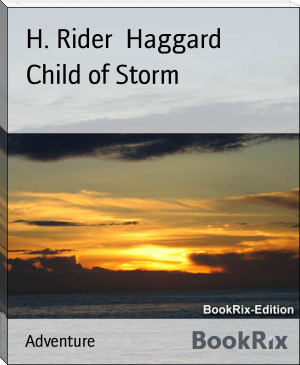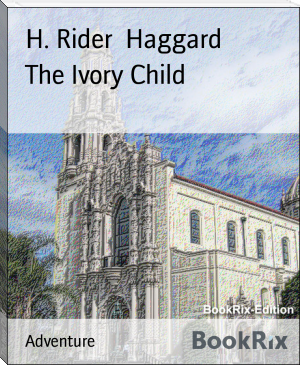Ayesha, the Return of She, H. Rider Haggard [books to read now .TXT] 📗

- Author: H. Rider Haggard
Book online «Ayesha, the Return of She, H. Rider Haggard [books to read now .TXT] 📗». Author H. Rider Haggard
“‘Yes, yes, that can’t be helped now, it must go as it is. You see I made up my mind to destroy it after all, and it was already on the fire when the command came—the clear, unmistakable command—and I snatched it off again.’
“What Mr. Holly meant by this ‘command’ I do not know, for he would speak no more of the matter.
“I pass on to the last scene. One night about eleven o’clock, knowing that my patient’s end was near, I went up to see him, proposing to inject some strychnine to keep the heart going a little longer. Before I reached the house I met the caretaker coming to seek me in a great fright, and asked her if her master was dead. She answered No; but he was gone—had got out of bed and, just as he was, barefooted, left the house, and was last seen by her grandson among the very Scotch firs where we were talking. The lad, who was terrified out of his wits, for he thought that he beheld a ghost, had told her so.
“The moonlight was very brilliant that night, especially as fresh snow had fallen, which reflected its rays. I was on foot, and began to search among the firs, till presently just outside of them I found the track of naked feet in the snow. Of course I followed, calling to the housekeeper to go and wake her husband, for no one else lives near by. The spoor proved very easy to trace across the clean sheet of snow. It ran up the slope of a hill behind the house.
“Now, on the crest of this hill is an ancient monument of upright monoliths set there by some primeval people, known locally as the Devil’s Ring—a sort of miniature Stonehenge in fact. I had seen it several times, and happened to have been present not long ago at a meeting of an archaeological society when its origin and purpose were discussed. I remember that one learned but somewhat eccentric gentleman read a short paper upon a rude, hooded bust and head that are cut within the chamber of a tall, flat-topped cromlech, or dolmen, which stands alone in the centre of the ring.
“He said that it was a representation of the Egyptian goddess, Isis, and that this place had once been sacred to some form of her worship, or at any rate to that of a Nature goddess with like attributes, a suggestion which the other learned gentlemen treated as absurd. They declared that Isis had never travelled into Britain, though for my part I do not see why the Phoenicians, or even the Romans, who adopted her cult, more or less, should not have brought it here. But I know nothing of such matters and will not discuss them.
“I remembered also that Mr. Holly was acquainted with this place, for he had mentioned it to me on the previous day, asking if the stones were still uninjured as they used to be when he was young. He added also, and the remark struck me, that yonder was where he would wish to die. When I answered that I feared he would never take so long a walk again, I noted that he smiled a little.
“Well, this conversation gave me a clue, and without troubling more about the footprints I went on as fast as I could to the Ring, half a mile or so away. Presently I reached it, and there—yes, there—standing by the cromlech, bareheaded, and clothed in his night-things only, stood Mr. Holly in the snow, the strangest figure, I think, that ever I beheld.
“Indeed never shall I forget that wild scene. The circle of rough, single stones pointing upwards to the star-strewn sky, intensely lonely and intensely solemn: the tall trilithon towering above them in the centre, its shadow, thrown by the bright moon behind it, lying long and black upon the dazzling sheet of snow, and, standing clear of this shadow so that I could distinguish his every motion, and even the rapt look upon his dying face, the white-draped figure of Mr. Holly. He appeared to be uttering some invocation—in Arabic, I think—for long before I reached him I could catch the tones of his full, sonorous voice, and see his waving, outstretched arms. In his right hand he held the looped sceptre which, by his express wish I send to you with the drawings. I could see the flash of the jewels strung upon the wires, and in the great stillness, hear the tinkling of its golden bells.
“Presently, too, I seemed to become aware of another presence, and now you will understand why I desire and must ask that my identity should be suppressed. Naturally enough I do not wish to be mixed up with a superstitious tale which is, on the face of it, impossible and absurd. Yet under all the circumstances I think it right to tell you that I saw, or thought I saw, something gather in the shadow of the central dolmen, or emerge from its rude chamber—I know not which for certain—something bright and glorious which gradually took the form of a woman upon whose forehead burned a star-like fire.
“At any rate the vision or reflection, or whatever it was, startled me so much that I came to a halt under the lee of one of the monoliths, and found myself unable even to call to the distraught man whom I pursued.
“Whilst I stood thus it became clear to me that Mr. Holly also saw something. At least he turned towards the Radiance in the shadow, uttered one cry; a wild, glad cry, and stepped forward; then seemed to fall through it on to his face.
“When I reached the spot the light had vanished, and all I found was Mr. Holly, his arms still outstretched, and the sceptre gripped tightly in his hand, lying quite dead in the shadow of the trilithon.”
The rest of the doctor’s letter need not be quoted as it deals only with certain very improbable explanations of the origin of this figure of light, the details of the removal of Holly’s body, and of how he managed to satisfy the coroner that no inquest was necessary.
The box of which he speaks arrived safely. Of the drawings in it I need say nothing, and of the sistrum or sceptre only a few words. It was fashioned of crystal to the well-known shape of the Crux-ansata, or the emblem of life of the Egyptians; the rod, the cross and the loop combined in one. From side to side of this loop ran golden wires, and on these were strung gems of three colours, glittering diamonds, sea-blue sapphires, and blood-red rubies, while to the fourth wire, that at the top, hung four little golden bells.
When I took hold of it first my arm shook slightly with excitement, and those bells began to sound; a sweet, faint music like to that of chimes heard far away at night in the silence of the sea. I thought too, but perhaps this was fancy, that a thrill passed from the hallowed and beautiful thing into my body.
On the mystery itself, as it is recorded in the manuscript, I make no comment. Of it and its inner significations every reader must form his or her own judgment. One thing alone is clear to me—on the hypothesis that Mr. Holly tells the truth as to what he and Leo Vincey saw and experienced, which I at least believe—that though sundry interpretations of this mystery were advanced by Ayesha and others, none of them are quite satisfactory.
Indeed, like Mr. Holly, I incline to the theory that She, if I may still





Comments (0)